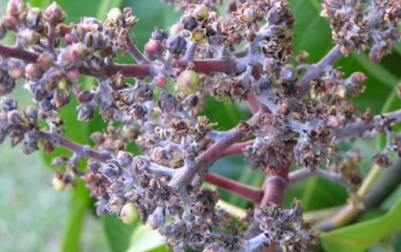Powdery mildew of mango caused by Oidium mangiferae Berthet is a widespread and most important disease of mango. It is most severe in the drier areas of the state when rain occurs during the flowering season. Worldwide, it is found in most mango growing areas.
Mango powdery mildew is a sporadic but very severe disease of mango leaves, panicles, and young fruits; up to 90 percent crop loss can occur due to its effect on fruit set and development.
Powdery mildew is primarily a disease of flowers, young shoots, and young fruits. The disease may cause foliar, inflorescence or fruit infection. The characteristic symptom of the powdery mildew disease is the white superficial powdery growth of the fungus on these parts having millions of conidia which are borne in chains on conidiophores, which later turns in to grey color.
Mildew pathogen attacks flowers resulting in their shedding. The sepals are relatively more susceptible than the petals. From a distance, the infected parts of the mango tree have a grayish haze resulting from the masses of conidia and fungal growth on the infected surface.
Young leaves are mostly infected on the underside, especially along the veins, but more susceptible varieties are also infected on the upper surface. Older leaves are more resistant to infection. Grayish, necrotic lesions or large, irregularly shaped spots may form on leaves.
Powdery mildew of mango
Mango is one of the popular fruits in the world due to its attractive color, delicious taste and excellent nutritional properties. Known for its sweet fragrance and flavor, the mango has delighted the senses for more than 4000 years. A celebrated fruit, mango, now produced in most of the tropical parts of the globe.
Wednesday, August 4, 2021
Popular Posts
-
History and Origin of Mango The mango has been known in India since very early times. It is referred to in Sanskrit literature as Amra and h...
-
This tropical fruit is high in vitamin C. Mango fruits contain 10-20 percent sugar and are important source of vitamin A. They have a rich,...
-
Uses of Mango and Nutritional Composition Mango is commonly eaten fresh and depending upon the cultivar may be consumed at an immature (unri...
-
The mango is believed to have been discovered as long as five to six thousand years in eastern India, Thailand, Myanmar, the Andaman Islands...





